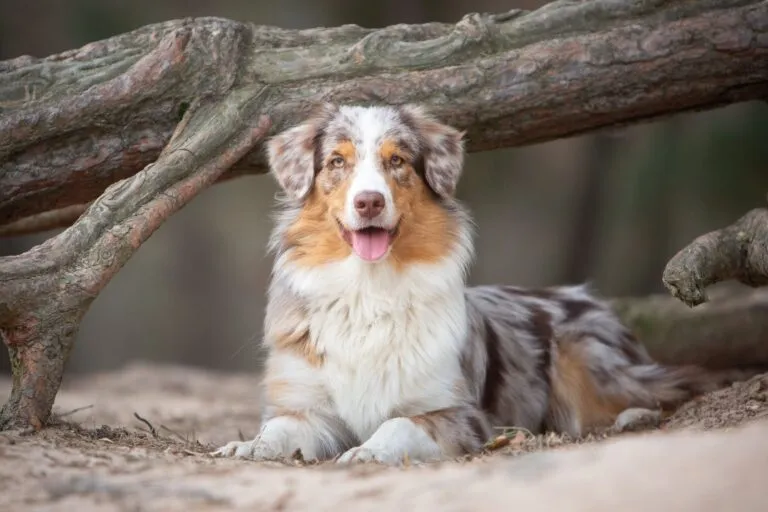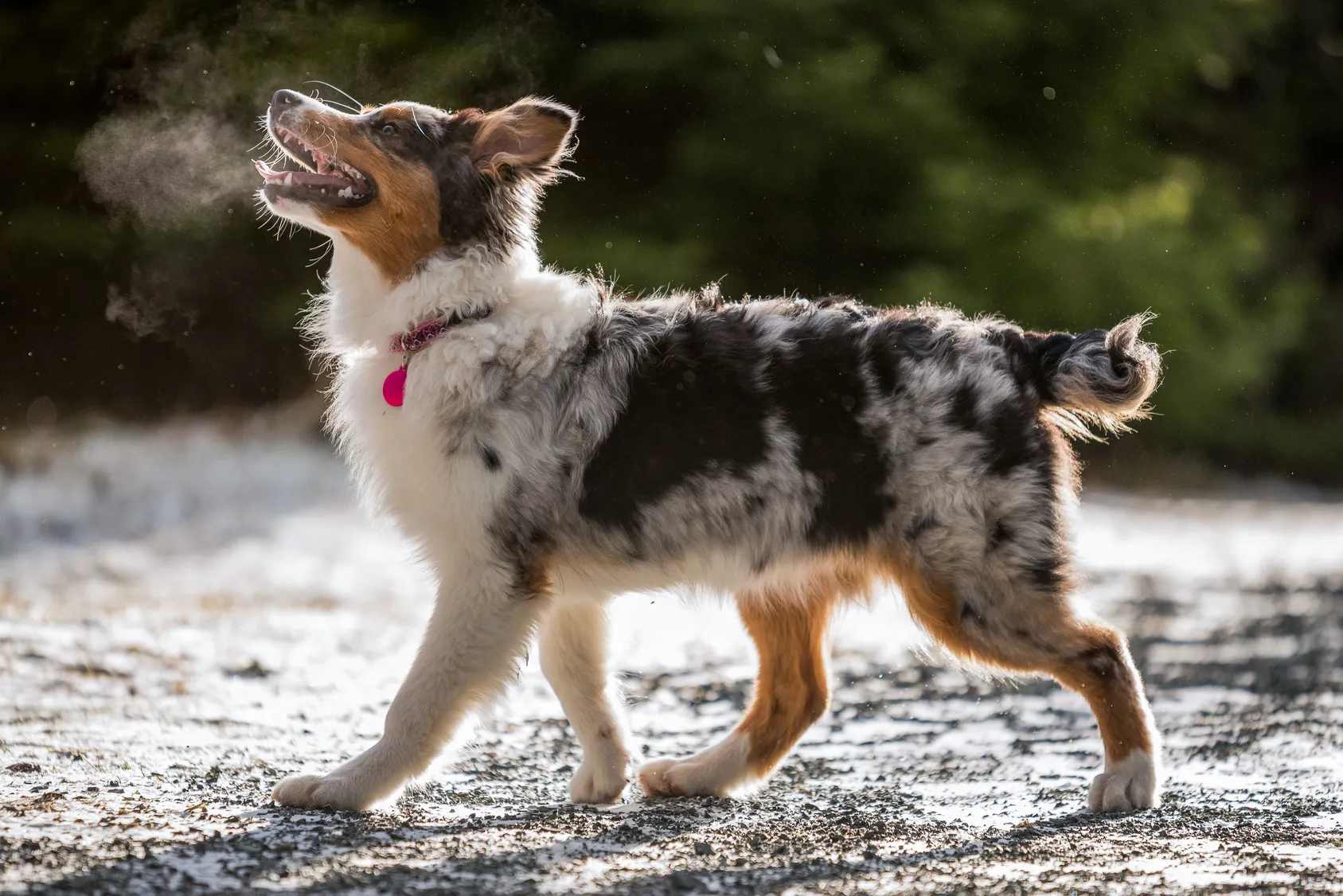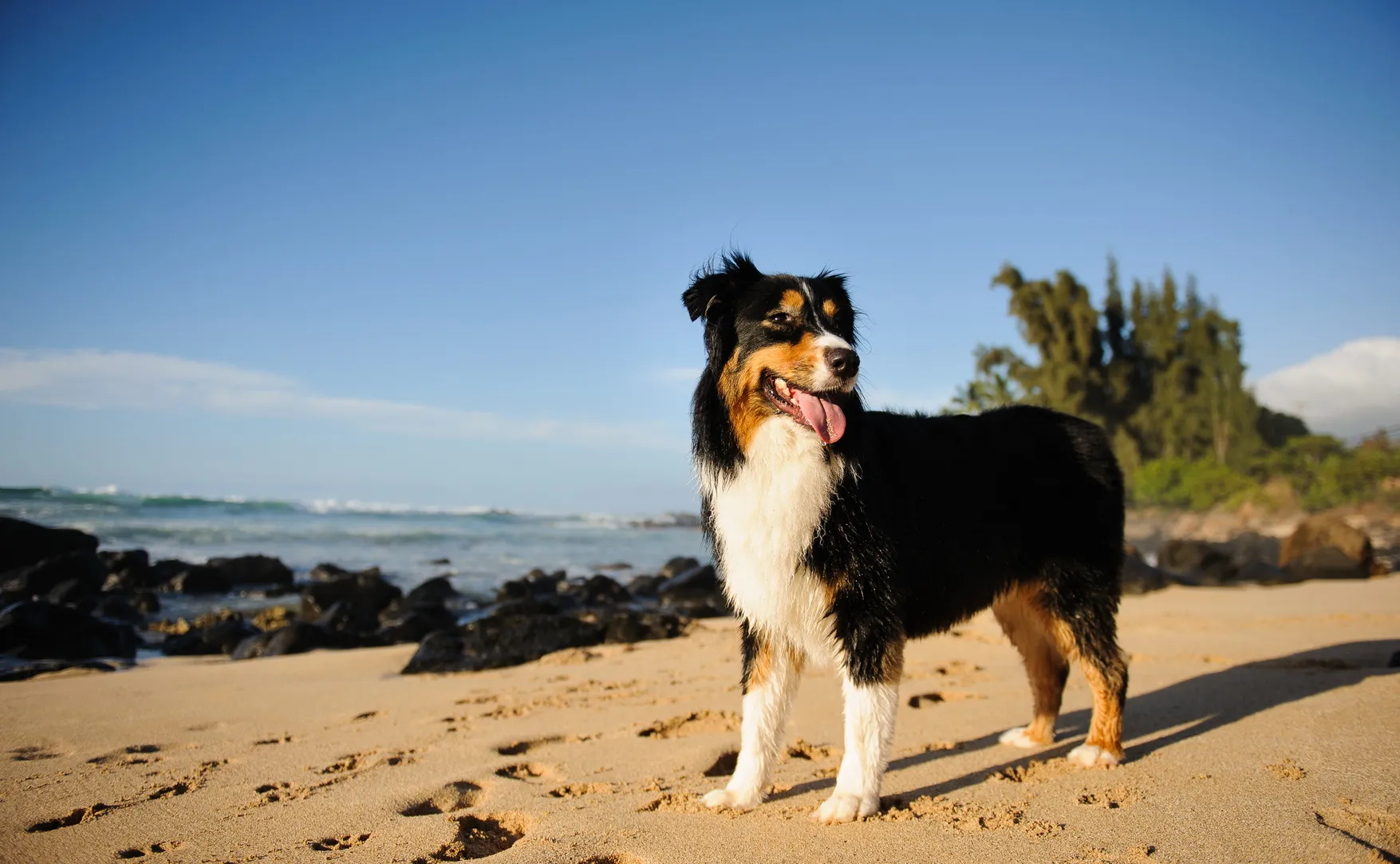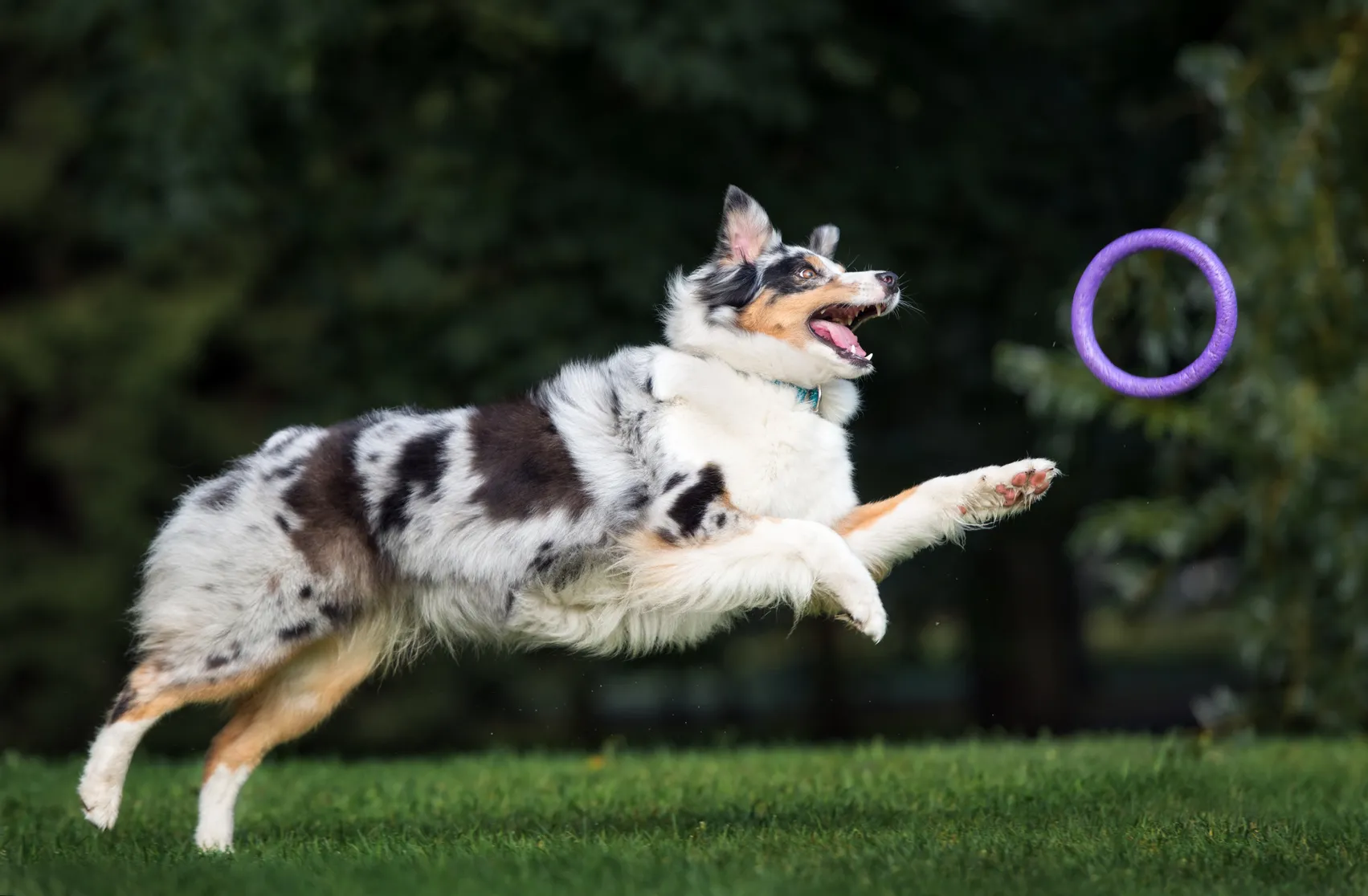Beagle
The Beagle's short legs can be deceiving – this medium-sized dog keeps you on your toes and is always full of surprises! This friendly breed is active, fearless and extremely clever.
Originally bred for herding, the attractive, medium-sized Australian Shepherd needs a varied and demanding selection of activities that challenge it mentally and physically.

© Heiko / stock.adobe.com
Australian Shepherds predominantly captivate with their lively temperament, enviable endurance and strong protective instinct. They are working dogs through and through and don’t cast off their innate herding and guarding instincts as family dogs. Work is a real passion for these active, willing-to-learn dogs that are always 100% committed to all tasks entrusted to them. They are very intelligent and docile and welcome all new challenges.
These lovable Aussies are equally very people-focused and have a real will to please. They like to oblige their owners and are happy to work together with them. The combination of their pronounced learning aptitude and willingness to obey their owners makes these former working dogs more and more popular as family pets. However, their desire to please the leader of the pack doesn’t mean that they blindly follow all their owner’s commands. As former herding dogs, Australian Shepherds are extremely headstrong and have a certain independent streak.
So, the Australian Shepherd’s great will to please and learn shouldn’t be confused with being easy to train. They do learn very quickly, but can also quickly adopt incorrect methods. Hence, their training requires consistency, directness, prudence, patience and empathy in equal measures. These intelligent and attentive dogs immediately detect weaknesses and take advantage. Many Australian Shepherds appear to know their owners better than they know themselves. However, with self-confidence, consistency and of course, lots of love, life with an Aussie is unproblematic and harmonious.

They are initially reserved when faced with strangers, but they soon become confident thanks to their friendly, amiable nature. Furthermore, they are patient and highly compatible with children and other pets. However, other animals, children, joggers or even cars can appeal to their herding instinct. Clear boundaries and a thorough selection of activities are therefore important for these zealous and versatile pedigree dogs.
Their origin as herding and cattle dogs can be detected through both their pronounced work ethic and intense urge for activity, as well as their strong and muscular but highly mobile and supple body. With males reaching 51 to 58cm in height and females 46 to 53cm, as well as a 22kg maximum weight, Australian Shepherds are medium-sized but extremely lightweight dogs. They move freely and effortlessly and have a great aptitude for many types of dog sport.
As working dogs, they have a robust physique that should never appear too large. The Aussie’s slightly domed head and snout of a similar length are well-proportioned to the harmonious body. They have a strong scissor bite and triangular ears set high on the head. When they are concentrating or paying close attention, the ears tip slightly forward or to the side. The hereditary stub tail is typical for some dogs of this breed and is known as a natural bobtail (NBT).
Thanks to its strong undercoat, the Australian Shepherd’s flat, almost slightly wavy fur is highly weather-resistant. The crest and neck ruff are hairier for males than for females. For both sexes, the hair is short and flat on the head, outside of the ears, front of the forelegs and underneath the ankle joints. The main reason for the popularity of the breed must surely be due to the wealth of fur colours possible. There are fundamentally four basic colours, which can offer 16 potential colours variations with different combinations and markings.
The four base colours are:
There are then sixteen possible fur colours:
For all colours of Australian Shepherd, the eyes and ears are overwhelmingly dominated by colours other than white. White markings are allowed, but white should never be the predominant colour. The applicable breed standard accepts neither white spots on the body nor a fully unpigmented nose (Dudley nose). The eye colour of these unusual pedigree dogs is just as diverse as the fur. Blue, brown, amber and every other variation or combination of these colours, including marks and marbling are permitted.
 © everydoghasastory / stock.adobe.com
© everydoghasastory / stock.adobe.com
Contrary to what the name suggests, the homeland of this versatile pedigree breed is North America, not Australia. However, the actual origin of the breed has hitherto not been retraceable, hence only mere theories exist about the Australian Shepherd’s ancestors. The most common theory claims that Basque shepherds took the dogs with them from Australia to the US in the 19th century, in particular at the time of the gold rush around 1840. The Basque immigrants took them with them as herding dogs for their merino sheep, which became known as “Australian sheep” in North America.
This eager working dog quickly made a name for itself on the farms and ranches of the US. Enthused by the diverse possibilities, ranging from herding tasks to deployment as a guard dog, farmers began to breed these pedigree dogs in a targeted manner. The dogs also impressed their audience at Western shows and rodeos and gained popularity. In 1957, the Australian Shepherd Club of America (ASCA) opened the first stud book, but a uniform standard for the breed was only established 20 years later. The American Kennel Club’s (AKC) breed standard came into effect in 1993. Three years later in 1996, the FCI (Fédération Cynologique Internationale) finally recognised the Australian Shepherd as an independent dog breed. The FCI assigned the Aussie with standard number 342 in group 1 of Sheep Dogs and Cattle Dogs in section 1 under Sheepdogs.
Though some Australian Shepherds still guard and herd sheep and other cattle, the majority are now kept as family and companion dogs. Two different lines have emerged in the breed corresponding to their deployment. There is a working line, whereby the original herding characteristics and instinct are preserved and fostered, as well as a somewhat calmer line, which gives greater prominence to calmness and a curbed temper and is therefore better suited for life as a family dog. However, the calmer line still packs more energy than many a football team. It’s easy to forget this when buying a charming puppy, and it’s not uncommon for new owners to soon feel over-challenged once they are back home.
If you’re interested in an Aussie, you should give real thought as to whether you are willing to adapt your life to such a temperamental character. Only once you can unequivocally answer this question with a “yes” should you start searching for a suitable breeder. Don’t let yourself be tempted to buy a puppy at a bargain price. Such “bargains” are mainly animals from mass breeding establishments that wish to get rich from the booming business with the new fashion dog and show no concern for the animals’ health or character. Such unregulated Aussies haven’t undergone sufficient health checks and will consequently end up sick on a regular basis.
It’s a fact that breed-specific hereditary diseases have cropped up increasingly in the last few years, which can unfortunately also be traced back to the breed’s growing popularity and the resulting lack of control over the breeding process. The typical diseases the Australian Shepherd has to contend with include joint problems such as hip and elbow dysplasia (HD and ED), ocular diseases such as cataracts and PRA (progressive retinal atrophy), epilepsy and dentition and dental abnormalities. Like with Collies, the so-called MDR1 defect also develops for many Australian Shepherds and leads to oversensitivity to numerous drug substances. When two types of merle-coloured dogs are paired, the offspring can often end up deaf and/or blind. Hence, paired “merle and merle” is forbidden as torture breeding in some countries.
Considering these breed-specific diseases, those who buy puppies should undoubtedly consult a competent and reliable breeder. This is the only way you can be sure that your puppy comes from a controlled breed in perfect health. By doing so, you ensure your own dog lives a long and healthy life, as well as making an important contribution to the health of the breed on the whole.
Diet is equally essential for keeping your Aussie in good physical health. As with most dog breeds, it’s recommended that Australian Shepherds receive a food made up of lots of meat (at least 70%), as well as fruit and vegetables (approx. 20-30%). Regardless of whether you opt for dry or wet food, you should make sure the quality is absolutely tip-top. The ingredients list on the packaging indicates whether the composition is sufficient and whether all important nutrients that your dog required are contained in the food. Excessive fillers, sweeteners, artificial flavour enhancers and chemical preservatives have no place in the food, just like excessive grain, and mainly indicate low-quality food. The so-called BARF (biologically appropriate raw food) method has become more and more popular recently. Just like with cooking yourself, here you of course have the greatest control over the quality of the food.
Giving an Australian Shepherd a healthy balanced diet with all important nutrients is fundamental but really easy. Aussies generally don’t tend to be overweight or prone to allergies. Nevertheless, you should of course adapt the food to your dog’s individual needs. Puppies that are still in the growth phase certainly need a different food to adult dogs, whilst more tranquil seniors require different ingredients to adult dogs that undertake more daily activity. Aside from age, weight, sex, activity level and state of health also play a role in choosing the right food. Both the ingredients and the quantity and frequency of daily meals should be adapted to these particular factors. Hence, it’s recommended to give puppies four smaller meals per day, whilst an adult Aussie only requires two meals per day. Besides, all dogs need fixed meal times and a period of calm after eating – regardless of their age.
Aside from the right diet and annual routine vet check-ups, you can do a lot to ensure your dog remains healthy and well cared-for. An important part of grooming an Australian Shepherd is to brush its fur on a daily basis, in order to remove loose hairs and dirt and avoid felting. In addition, you should check the ears, teeth, paws and claws around once a week and clean and cut them. With this regular grooming schedule, your dog won’t just look good and be in good health, but the connection between you both will be strengthened.
 © otsphoto / stock.adobe.com
© otsphoto / stock.adobe.com
However, the Australian Shepherd undoubtedly poses greater demands in terms of housing than for nutrition or grooming. Even animals from “family dog breeds” with a somewhat restricted temperament still demand a huge amount of action and activity.
An Australian Shepherd is certainly no dog for couch potatoes and casual Sunday walkers. Pure conditioning training like walks lasting for hours, running alongside the bike or playing fetch isn’t enough for this demanding pedigree breed. The intelligent and willing-to-learn Aussie requires a selection of activities that boost it both physically and mentally. Taking in different types of dog sport or training as a rescue, therapy or guide dog are recommended.
Physically and mentally stimulated dogs will definitely integrate better into the family than under-challenged and bored dogs that tend to quickly develop bad habits. They will willingly submit to people that challenge them in accordance to their aptitudes and act as loyal companions. In addition, well socialised, trained and stimulated Australian Shepherds will also accept it when there’s sometimes nothing to do. Periods of calm and relaxation are just as important as physical activity and mental stimulation in order to live in harmony with your dog.
The Beagle's short legs can be deceiving – this medium-sized dog keeps you on your toes and is always full of surprises! This friendly breed is active, fearless and extremely clever.
The Golden Retriever is still one of the most popular dog breeds, especially with families. It is defined not just by its docility, but shows numerous other qualities too. Read in the following article everything you need to know about the Golden Retriever.
The German Shepherd is one of the most popular utility dog breeds in the world, though the willing-to-learn and people-focused nature of these versatile dogs also makes them suitable for family life.